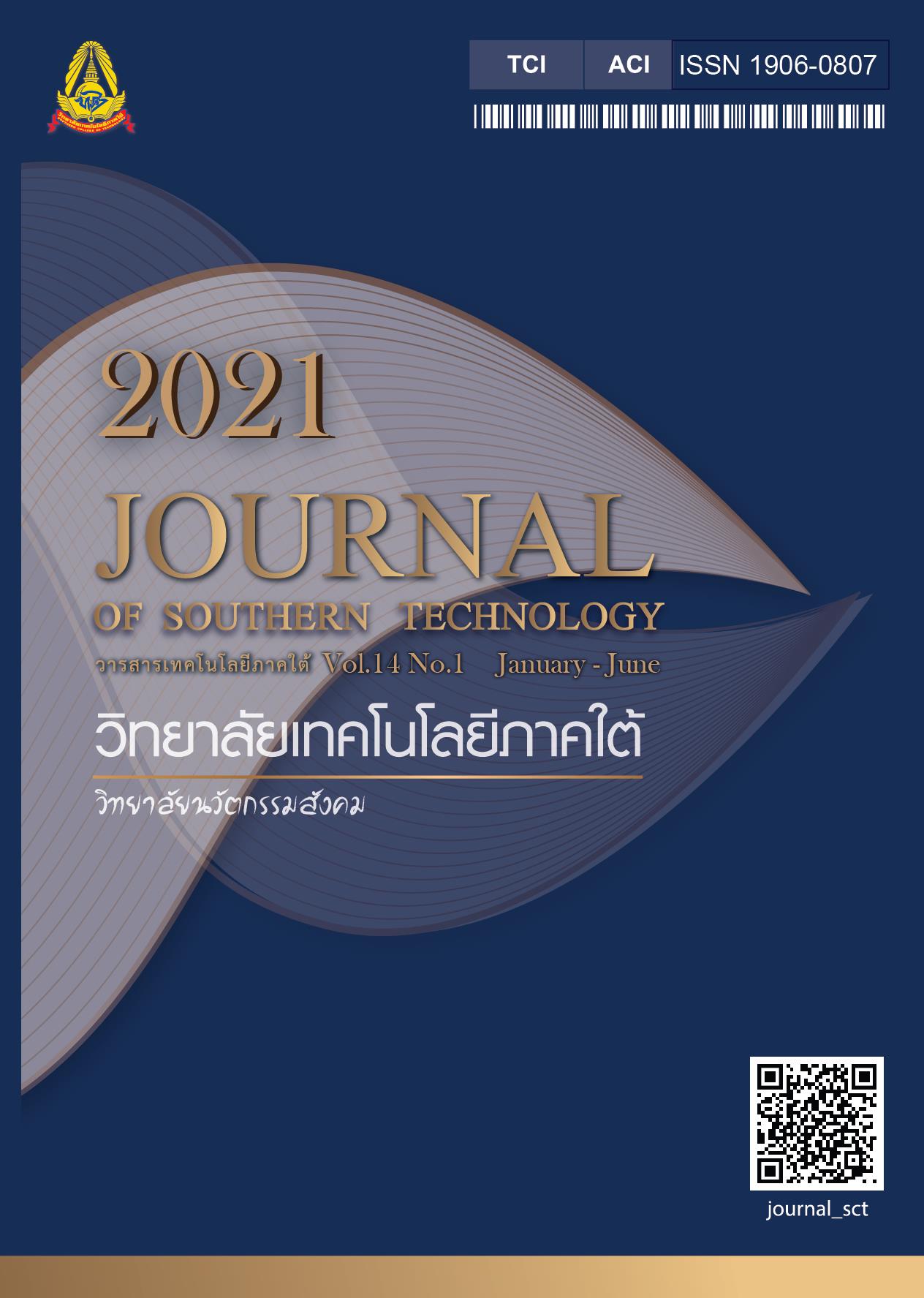การวิเคราะห์ต้นทุนและผลตอบแทนของธุรกิจโฮมสเตย์เกิดใหม่ขนาดเล็ก: กรณีศึกษาโฮมสเตย์ชุมชนท่าฉาง จังหวัดสุราษฎร์ธานี
Main Article Content
บทคัดย่อ
กลุ่มโฮมสเตย์ชุมชนท่าฉางเป็นวิสาหกิจชุมชนขนาดเล็กมีสมาชิก 12 ครัวเรือน ก่อตั้งเมื่อปี 2554 แบ่งออกเป็น
โฮมสเตย์บนบกจำนวน 5 หลัง และโฮมสเตย์ในทะเลจำนวน 7 หลัง ธุรกิจของกลุ่มประสบปัญหาหลายประการโดยเฉพาะด้านการจัดการ การตลาดและการเงิน ประเด็นปัญหาของชุมชนท้องถิ่นเหล่านี้ได้รับความสนใจจากคณะผู้วิจัยและเลือกเป็นหัวข้อวิจัยเพื่อเป็นแนวทางในการสร้างศักยภาพด้านการเงินแก่กลุ่มวิสาหกิจชุมชนด้านการท่องเที่ยวให้สามารถดำเนินธุรกิจได้
อย่างยั่งยืน งานวิจัยชิ้นนี้มุ่งเน้นไปในเชิงการวิเคราะห์ศักยภาพทางการเงินโดยมีวัตถุประสงค์เพื่อวิเคราะห์ต้นทุนและผลตอบแทนของการทำธุรกิจโฮมสเตย์ขนาดเล็ก ข้อมูลที่ได้รับสามารถนำไปกำหนดจุดเสมอตัวและราคาแพ็คเกจท่องเที่ยว
ที่เหมาะสมสำหรับการทำธุรกิจ เก็บข้อมูลแบบสัมภาษณ์กึ่งมีโครงสร้าง สัมภาษณ์ผู้ประกอบการโฮมสเตย์ทั้งหมดระหว่างมิถุนายน-สิงหาคม 2560 สรุปผลข้อมูลด้วยสถิติเชิงพรรณนาและวิเคราะห์ข้อมูลด้วยเครื่องมือการวิเคราะห์ทางการเงินและการลงทุนระยะยาว ผลการศึกษา พบว่า เงินลงทุนเริ่มแรกของโฮมสเตย์บนบกและโฮมสเตย์ในทะเลเฉลี่ย 760,462 บาท และ 408,509 บาท ตามลำดับ มีประมาณการรายได้เท่ากับ 155,097 บาท และ 153,929 บาท/ปี ตามลำดับ ราคาแพ็คเกจท่องเที่ยวปัจจุบันเท่ากับ 950 บาท/คน ราคานี้รวมห้องพัก 1 คืน อาหาร 3 มื้อและบริการท่องเที่ยว 1 วัน ราคาที่กำหนดสูงกว่าจุดเสมอตัวของธุรกิจร้อยละ 46.4 เมื่อวิเคราะห์ผลตอบแทนจากการลงทุนกำหนดอายุโครงการ 10 ปี อัตราผลตอบแทนคาดหวัง 10% พบว่า โฮมสเตย์บนบกมีมูลค่าปัจจุบันสุทธิติดลบเท่ากับ –429,041.4 บาท อัตราผลตอบแทนภายใน 7.6% และระยะเวลาคืนทุนเท่ากับ 8 ปี 4 เดือน ในขณะที่โฮมสเตย์ในทะเลมีมูลค่าปัจจุบันสุทธิ 264,349 บาท อัตราผลตอบแทนภายใน 13.3% และระยะเวลาคืนทุนเท่ากับ 5 ปี 11 เดือน จากผลการศึกษาแสดงว่า ธุรกิจโฮมสเตย์ในทะเลเป็นโครงการที่มีศักยภาพด้านการเงินด้านรายได้ ต้นทุนและผลตอบแทน
Article Details
- ผู้เขียนต้องยินยอมปฏิบัติตามเงื่อนไขที่กองบรรณาธิการวารสารกำหนด และผู้เขียนต้องยินยอมให้บรรณาธิการ แก้ไขความสมบูรณ์ของบทความได้ในขั้นตอนสุดท้ายก่อนเผยแพร่
- ลิขสิทธิ์บทความเป็นของผู้เขียน แต่วารสารเทคโนโลยีภาคใต้คงไว้ซึ่งสิทธิ์ในการตีพิมพ์ครั้งแรก โดยเหตุที่บทความนี้ปรากฏในวารสารที่เข้าถึงได้จึงอนุญาตให้นำบทความไปใช้เพื่อประโยชน์ทางการศึกษา แต่มิใช่เพื่อการพาณิชย์
เอกสารอ้างอิง
Bank of Thailand. (2017). Financial Policy Report. Retrieved on September 30, 2017, from https://www.bot.or.th/Thai/MonetaryPolicy/MonetPolicyComittee/MPR/DocLib/Press_MPR_TH_Sep17_pr2gknsm.pdf. [in Thai]
Boontasorn, N., Mana, S., & Poltecha, B. (2014). The development of community marketing and promote tourism for community business enterprise for sustainable tourism of Hunka District, Chainat Province. Chandrakasem Rajabhat University Journal, 20(39), 39-48. [in Thai]
Buabangplu, P. (2018). Guidelines for management of sustainable eco-tourism: a case study of KhaoKhitchakut National Park, Chantaburi Province. Rampaipanee Research Journal, 12(2), 91-101. [in Thai]
Dent, J.F. (1991). Accounting and organizational cultures: a field study of the emergence of a new organizational reality. Accounting, Organizations and Society, 16(8), 705-732.
Downie, N. (1997). The use of accounting information in hotel marketing decisions. International Journal of Hospitality Management, 16(3), 305-312.
Federation of Accounting Professions. (2015). Accounting Standard Section 18 Revenue. Retrieved May 12, 2017, from www. fap. or. th/ images/column_14509 24 281. [in Thai]
Horngren, C.T., Dartar, S.M., & Rajan, M.V. (2015). Cost Accounting: A Managerial Emphasis. England: Pearson Education Limited.
Janaji, S. A., & Ibrahim, F. (2020). A Case of Homestays in Brunei as a Means of Socio-Economic Development. International Journal of Entrepreneurial Research, 3(4), 133-141.
Kontogeorgopoulos, N., Churyen, A., & Duangsaeng, V. (2015). Homestay tourism and the commercialization of the rural home in Thailand. Asia Pacific Journal of Tourism Research, 20(1), 29-50.
Mankatitham, W. (2011). Homestay Style Reflective Architectural Identities of Samutsongkhram Province. Retrieved March 18, 2020, from http://www.ssruir.ssru.ac.th/ bitstream/ ssruir/338/1/061-53.pdf. [in Thai]
Ministry of Tourism and Sports. (2020). Tourism Statistic 2019. Retrieved May 12, 2020, from https://www.mots.go.th/more_ news_new.php?cid=585. [in Thai]
Nantarat, P. (2012). Development of Community Enterprises as Learning Center. Full Report of the Department of Agricultural Promotion. Retrieved March 18, 2020 from http://www.research.doae.go.th/webphp/webmaster/fileworkres/13315175719.pdf. [in Thai]
Nitikasetsoontorn, S. (2015). The success factors of community-based tourism in Thailand. NIDA Development Journal, 55(2), 24-58.
Parinyasutinun, U. (2017). Community enterprise: the paradox of the competition of business. Veridian E-Journal, 37(2), 131-150. [in Thai]
Pellinen, J. (2005). Making price decisions in tourism enterprises. Hospitality Management, 22 (2), 217-235.
Petprasert, N. (1995). Community Business: Possible Pathway. Bangkok: Thailand Research Fund. [in Thai]
Puangpejara, K. (2018). The marketing promotion by community’s participation of Rai San Fan community enterprise, Nikhom Sang Toneng Sub-district, Mueang District, Lop Buri Province. Veridian E-Journal, 11(2), 1455-1467. [in Thai]
Rouse, P., Putterill, M., & Ryan, D. (2002). Integrated performance measurement design: insights from an application in aircraft maintenance. Management Accounting Research, 13, 101-130.
Royal Forestry Department. (2005). Ecotourism. Retrieved March 28, 2017, from http://chm-thai.onep.go.th. [in Thai]
Sang-Aran, S. (2005). Ecotourism. Retrieved March 5, 2017, from http://www.dnp.go.th/NPO/ html/Tour/Eco_Tour.html. [in Thai]
Sangkhakorn, K. (2006). Basic Knowledge and Management Standards of Homestay. Social Research Institute, Chiang Mai University. Retrieved March 20, 2017, from www.sri.cmu.ac.th. [in Thai]
Siriwiwattanakul, P., & Nitirojntanad, K. (2016). Management Accounting Practices of Hotel Business in Thailand. In Proceedings of the Fourth European Academic Research Conference on Global Business, Economics, Finance and Banking, 7-9 July, 2016, 1-9.
Sukmak, N. (2014). Other Revenue Other Expenses. Retrieved March, 15, 2017, from http://www. openerpthailand.org. [in Thai]
Surat Thani Provincial Statistical Office. (2017). Number of Tourists of Surat Thani Province 2015-2016. Retrieved on March 10, 2017, from http://surat.nso.go.th/index. php? option=com_ content&view =article&id = 430 : ep13 & catid=88&Itemid=621. [in Thai]
Tha Chang District E-Information Center. (2020). General Information of District. Retrieved on May 12, 2020, from http://www.oic. go.th/INFOCENTER1/138/
Tourism Authority of Thailand. (2016). Important Homestay in Seven Sub-district of Surat Thani. Retrieved March 10, 2017, from https://thai.tourism Thailand.org. [in Thai]
Tourism Authority of Thailand. (2019). National Ecotourism Practices, Bangkok. Retrieved March 17, 2020, from https:// portal. tourism Thailand.org/fileadmin/downloads/ pdf.pdf. [in Thai]
Vejjabussakorn, S. (1995). Ecotourism. Bangkok: Kasetsart Marine National Park Publication Printing. [in Thai]
Wongwangphoem, P., Pipitkun, K., & Thaithong, P. (2018). Factors influencing the success of community enterprises in Roi-Et province. Phimoldhomma Research Institute Journal, 5(2), 191-200. [in Thai]
Worrachat, P. (2018). Factors influencing the strength of community enterprises management
in Surin Province. Journal of Politic, Management, and Laws, 10(2), 285-310. [in Thai]

